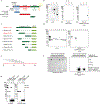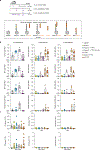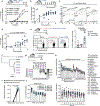Discovery and engineering of the antibody response to a prominent skin commensal
- PMID: 39662508
- PMCID: PMC12045117
- DOI: 10.1038/s41586-024-08489-4
Discovery and engineering of the antibody response to a prominent skin commensal
Abstract
The ubiquitous skin colonist Staphylococcus epidermidis elicits a CD8+ T cell response pre-emptively, in the absence of an infection1. However, the scope and purpose of this anticommensal immune programme are not well defined, limiting our ability to harness it therapeutically. Here, we show that this colonist also induces a potent, durable and specific antibody response that is conserved in humans and non-human primates. A series of S. epidermidis cell-wall mutants revealed that the cell surface protein Aap is a predominant target. By colonizing mice with a strain of S. epidermidis in which the parallel β-helix domain of Aap is replaced by tetanus toxin fragment C, we elicit a potent neutralizing antibody response that protects mice against a lethal challenge. A similar strain of S. epidermidis expressing an Aap-SpyCatcher chimera can be conjugated with recombinant immunogens; the resulting labelled commensal elicits high antibody titres under conditions of physiologic colonization, including a robust IgA response in the nasal and pulmonary mucosa. Thus, immunity to a common skin colonist involves a coordinated T and B cell response, the latter of which can be redirected against pathogens as a new form of topical vaccination.
© 2024. The Author(s), under exclusive licence to Springer Nature Limited.
Conflict of interest statement
Competing interests: M.A.F. is a cofounder of Kelonia and Revolution Medicines, a member of the scientific advisory boards of the Chan Zuckerberg Initiative, NGM Biopharmaceuticals and TCG Laboratories/Soleil Laboratories, and an innovation partner at The Column Group. D.B., Y.E.C., K.D.B., P.V.L., M.I.M., C.O.B., Y.B. and M.A.F. are inventors on patent applications submitted by Stanford University and the Chan Zuckerberg Biohub that cover methods for using engineered bacteria to elicit antigen-specific immune cells.
Figures














Update of
-
Discovery and engineering of the antibody response against a prominent skin commensal.bioRxiv [Preprint]. 2024 Jan 23:2024.01.23.576900. doi: 10.1101/2024.01.23.576900. bioRxiv. 2024. Update in: Nature. 2025 Feb;638(8052):1054-1064. doi: 10.1038/s41586-024-08489-4. PMID: 38328052 Free PMC article. Updated. Preprint.
References
ADDITIONAL REFERENCES
MeSH terms
Substances
Grants and funding
LinkOut - more resources
Full Text Sources
Research Materials
Miscellaneous

